This page collects visuals from some of the larger talks and lectures I've given over the years.
Many of these talks are complex; often, I try to put one set of ideas in the visuals and another in the lecture itself. These notes generally include only the visual argument.
If you're interested in having me speak, please contact Eastgate or email info@eastgate.com .
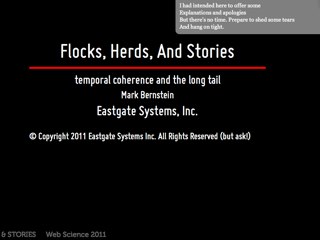
Herds, Flocks, & Stories
From Web Science 2011, an observation about fluctuations in Web traffic leads to speculations on ways the Web could collapse.
One of the very few papers on statistics and simulation to be delivered to a scientific conference in verse.
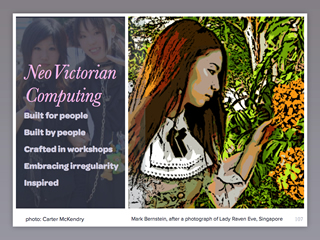
NeoVictorian Computing
We software creators woke up one day to find ourselves living in the software factory. The floor is hard, from time to time it gets very cold at night, and they say the factory is going to close and move somewhere else. We are unhappy with our modern computing and alienated from our work, we experience constant, inexorable guilt.
I propose NeoVictorian Computing which, drawing on elements of contemporary culture, might succeed in restoring creative integrity, beauty, and independence to the craft of software. Invited talk at OOPSLA 2007. (QuickTime, 4M)
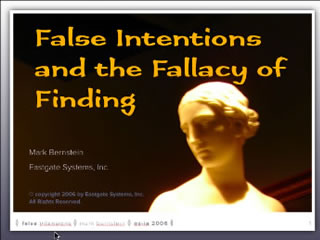
False Intentions and the Fallacy of Finding
Information architecture has expressed great faith in classification and in search. This works well for fact checking and for properly filling out forms, but these are not why we read and write. Meaning in real hypertexts and real Web sites lies between the modules — just as it does in poems, speeches, and films. Multivalence is not a vice; multiplicity of meaning is central to the complexity of the real world — the world of shopping and politics and business. In socially-constructed sites, as Michael Joyce argued years ago, the information architect must design a structure for what does not yet exist. Patterns of hypertext can help understand and shape these structures; asking readers to rationalize their intentions is likely to yield rationalizations. (Quicktime, 5M)
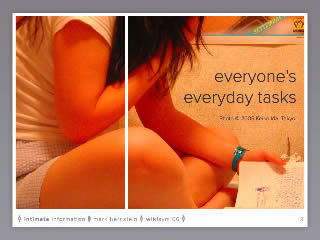
WikiSym
Intimate Information: organic hypertext structure and incremental formalization for everyone’s everyday tasks. WikiSym, Odense Denmark, August 2006 (Quicktime 4M) (pdf 46MB) Update: links fixed
Much of our most important writing is written to ourselves and to our immediate circle of family, friends, and allies. This intimate or nobitic information includes not merely calendars and grocery lists, but also work for planning our future endeavors, as well as correspondence to our future selves and our progeny. Tinderbox is a tool for making, analyzing, and sharing notes — offers a range of representational tools ranging from conventional links and WikiLinks to prototype inheritance and spatial hypertext. People exploit this complex tool set to help discover and express the structure of everyday ideas; of particular interest is the problem of creating structure for work that has not yet been written and that will evolve in unexpected directions. The history of constructive hypertext and the success of early wikis provides invaluable guidance for structuring nobitic writing tools.

BlogHui
What Good Is A Weblog? BlogHui, Wellington, New Zealand. March 2006. (quicktime, 3.2M)
"The Ultimate Aim of All Creative Activity Is the Weblog!" Why is this claim preposterous, while the Bauhaus manifesto raises no objection? Weblogs today are written and read by millions, and yet we have almost no useful discussion of weblog excellence. What shall we emulate? What should be deplore?
The romantic view of weblogs claims that we shouldn't worry about craft, that our weblogs are excellent because we ourselves are excellent. Skeptics and journalists tell us that weblogs are filled with mundane self-indulgence: "I ate a cheese sandwich." The cheese sandwich is indeed familiar to weblog readers; in this talk I explore the eight key uses of the cheese sandwich in serious weblog writing.

The Ultimate Goal Of All Creative Activity
Architecture strives to reconcile engineering to art; Information Architecture set out to rein in the pesky creatives. The surprising dearth of architecture in Information Architecture was remarkable, but for many years was seldom mentioned. Gropius wrote that "The ultimate end of all creative activity is the building!" Today, that aspiration is the web site. Information Architecture Summit, Portland, Oregon, USA. 2003. (Quicktime) (29 Jan 06: fixed link)

Protecting The Blogosphere
We've got a big, thriving blogosphere. Blogs are in the news. We have millions of weblogs. The subway grafitti in Munich has links to weblogs.
We also have lots of weblog readers. A few weblogs have huge circulation and influence. We have global weblog conferences. We see weblogs everywhere. At this moment of weblog triumph, I want to talk about the urgent need to save the blogosphere. To preserve the ecology of weblogs.
Not simply to save the blogosphere from regulation, though that's important. Certainly, not to save it from commerce: there is nothing outside the economy.
But we could wreck the blogosphere by accident. Or, we could find, one day soon, that we'd used and abused it in ways that ruined it -- ways we didn't know were harmful.
Blogtalk Downunder, Sydney, Australia, 2005. (pdf 36M)

Art
As research in human-computer interaction has grown more methodologically rigorous, we are in danger of losing the ability to notice -- or believe in -- the kinds of changes we most want our systems to enable. We have good ways to study small improvements in computer systems, but we have great difficulty in exploring the ways our tools can improve and transform our lives.
As an example, I discuss Lindsay's Story, an anecdotal account from Prof. Pam Taylor's dissertation of a secondary-school student's encounter, over the course of two years, with a hypertextual art portfolio project. Taylor suggests that the tool's hypertextuality helped the student recognize and act on a pattern of domestic abuse. It is far easier to explore incremental improvements in UI widgets than to explore transformative experiences, but our quest for rigour should not blind us to the effects we're trying to create.
National Art Education Association, Boston, USA, 2005. (pdf 14M)
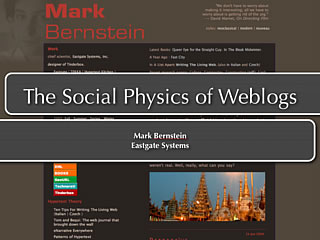
The Social Physics of Weblogs
- What is the impact of daily writing?
- What is the impact of writing well?
- What are the economics of weblogs?
- How can we control flames and trolls?
- How do blogrolls and link policies shape the blogosphere?
- What is weblog fiction? How shall we approach it?
- How shall we gain value from archives?
Academic research in weblogs has often focused on narrow literary questions of genre, on establishing the legitimacy or popularity of the medium, or on the sociology of the weblog community. Many important aspects of weblog writing and weblog tools have scarcely been studied.
Blogtalk II, Vienna, Austria, 2004. (pdf 15M)

Software Aesthetics
The very idea of software aesthetics seems improbable. Indeed, it seems a fraud. Spin, perhaps perpetrated by some catalog or the public relations campaign of a firm of industrial designers. But finding meaning -- and beauty -- in computational space is very possible and -- if we are to survive the 21st century -- it is also very urgent.
We act as if we are ashamed of our machines. We act as if we did not believe our work to be the most vital, important cultural work we can do. This might be becoming modesty, but at some point it becomes a deception. If we have learned anything from a half century of the postmodern, it is to hold two ideas together at once. Much nonsense is said about the nature of the digital, but this is the real lesson we must learn: not ones and zeroes, but particle and wave -- together, one thing and once concept.
Not the GIRL, not the CAUSE, but both, together, at once. Not the struggle, nor the triumph. Both, and neither -- as they really are, not as the romantic or sentimental illusion or the forced dream, Art and science -- one thing. Together.
H2TPM, St. Denis, France, 2003 (pdf, 50M)
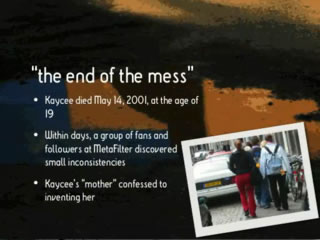
Stories in Weblogs
Weblog writers and digital storytellers alike have claimed authenticity and sincerity as their hallmarks. Each of these communities prizes personal narrative, and each tends to look askance at fiction and to mistrust craft.
Things aren't always what they seem. They never were. The borderlands of fiction are strange and magic places.
Digital Storytelling Festival, Sedona, Arizona, USA. (QuickTime, 5M)
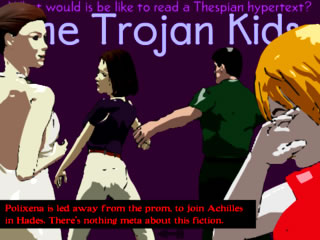
Card Shark and Thespis
This paper explores two exotic hypertext systems, tools suitable for hypertext narrative but dramatically unlike the tools currently in use. The customary reason for building a new system is to build a better system; here, I wanted to build a strange system, a hypertext environment that might let us step back from Storyspace and the Web in order to gain a better perspective. I do not wish to argue that these systems are better than, say, Storyspace...For our purposes, we need not be better, we need only be different.
Hypertext '01, Århus, Denmark (HTML/Flash)
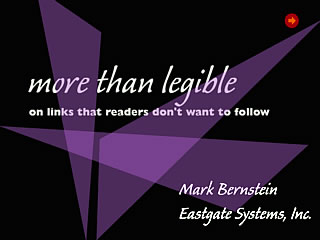
More Than Legible
Hypertext writers are often taught to label links with the greatest possible clarity, completeness and accuracy. Link anchors that describe their destination do reduce the likelihood of astonishment and disorientation.
They also ensure that readers will not follow links to things they don't want to read. If links are clear and candid, how can writers beg the audience's indulgence — especially for a distant or difficult pleasure?
Links (like all language) cannot say one thing. Multivalence is not a vice.
Hypertext 2000, San Antonio Texas USA (HTML/Flash)
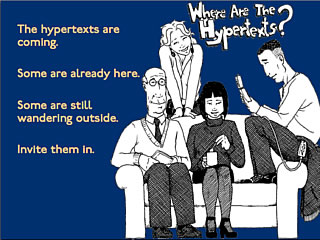
Where Are The Hypertexts?
In 1989, I impatiently asked a hypertext conference, "Where are the hypertexts?" That's still a good question. I still don't know the answer.
Our virtual shelves are far too bare. What's taking so long?
Hypertext '99 keynote address, Darmstadt, Germany. (pdf, 8M)